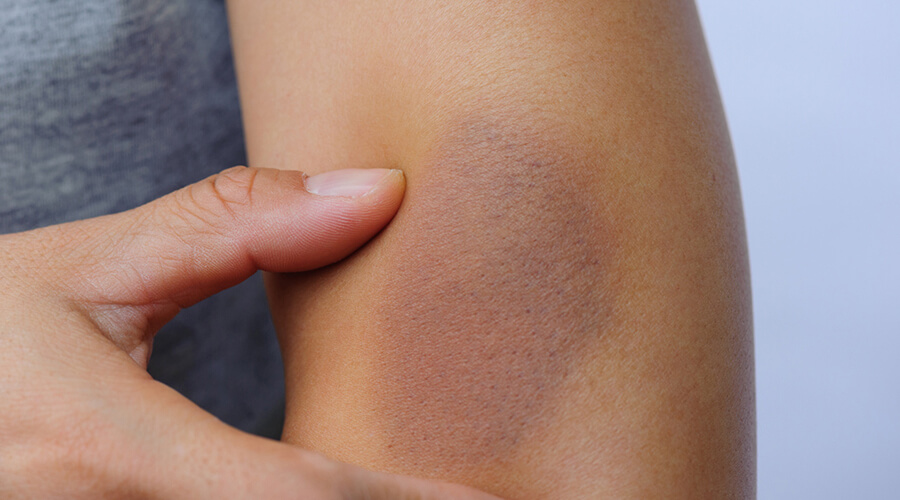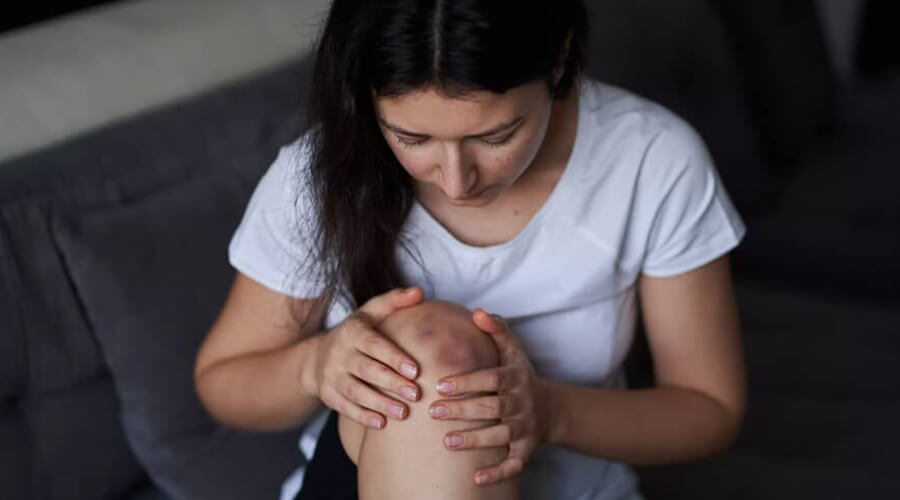



Purple patches, or haematomas, occur when an injury causes blood to leak from a damaged blood vessel into the tissues.
Blue, purple and green-yellow patches on the skin, most often caused by physical impact. In the case of a minor injury, the bruise is in the skin, while in the case of a more severe, deeper injury, the bruise is usually in the muscle tissue.
Where can a haematoma develop and why?
Haematoma can be found not only in the upper layer, but also in deeper areas such as under the periosteum. In more severe cases, such as skull injury, a very serious and severe condition can develop. Medical attention is required in such cases and others.
However, mild injuries can be an everyday occurrence, so bruises and purple spots can be completely commonplace. It is very common to develop a haematoma on the knee or a haematoma on the leg. Simply bumping into a hard and solid object can cause purple spots to form in these areas. Another common area is the arm. Like the leg, haematomas on the arm can form very easily.
In addition to impact, it may be more difficult to determine the cause of purple spots in some cases. This could be, for example, a bleeding disorder, taking anticoagulant medication or the weakening of blood vessels that is common in old age. In simple cases, where there is no major complaint, a cream can be applied to the purple patch to help the healing process.
When the purple patches appear on the leg, arm or any part of the body for no apparent reason, i.e. the bruising occurs without a blow, it is also called spontaneous or idiopathic bruising.
Purple spots on the body can occur for a number of reasons, including:
Blood clotting disorders: conditions such as blood clotting disorders, haemophilia or von Willebrand’s disease may increase the risk of spontaneous haemorrhage.
Vascular problems: vascular disorders, such as damage to the vascular wall, weakness of the vascular wall, or vascular blockage, can cause blood to spontaneously leak through the vascular walls and under the skin.
Inflammatory diseases: certain inflammatory conditions, such as vasculitis or rheumatoid arthritis, can cause bruising.
Side effects of medicines or supplements: certain medicines or supplements, such as blood thinners or aspirin, can cause haemophilia, which can lead to spontaneous bruising.
Traumatic or non-pressure skin injuries: sometimes subcutaneous haemorrhages can occur without damage to the skin, for example as a result of pressure, excessive force, lifting weights or massaging.
Skin changes with age: older people’s skin becomes thinner and the vascular system may weaken, which can increase the risk of spontaneous bruising.
Why does a haematoma change colour?
The characteristic colour of bruising in superficial injury is due to haemoglobin in the red blood cells. The changing colour of bruises is due to the compounds produced during the breakdown of haemoglobin. In most cases, these are absorbed and disappear during the healing process.
Let’s also look at how purple patches and haematoma are treate
How can a haematoma be treated?
Treatment of bruising depends on the underlying cause. If the bruising is caused by a disease, such as a blood clot, treatment of the underlying disease is essential to stop the bruising. If the bruising is caused by an accident, the most important step is to treat the wound and stop the bleeding.
A haematoma often resolves itself in a relatively short time. However, the removal of a purple patch can be accelerated by the use of an anti-pain cream. The use of a cream for blue green purple spots may be beneficial not only to speed up the healing of the discoloured area. The bruise can often cause the affected area to become tender and painful. However, this can be reduced by using a bruising cream. However, in addition to creams, some home remedies can also help.
The clotted hematoma
A clotted hematoma, also known as a blood clot, is a condition in which the blood in a hematoma clot coagulates and then changes shape and hardness. Ingrowing haematomas are usually blue-purple in colour and can cause swelling, pain and tenderness in the affected area.
The treatment of an ingrowing haematoma usually depends on the cause. Mild hematomas will usually dissolve on their own and warm compresses applied to the affected area can help relieve pain and swelling. However, treating more severe hematomas is not something you can do at home. In such cases, medical intervention may be necessary!
Treatment of bruising at home:
-the most commonly used method to remove bruising is to apply cold to the affected area. This helps to reduce swelling and relieve pain
-elevating the bruise site with a high pillow, which helps to improve blood flow and reduce swelling
-bruising can also be treated with a cream that can be easily applied at home
Although it is possible to speed up the healing process, the speed of bruising may depend on the injury and the treatment. Home treatment of bruising is not recommended if, for example, the size and shape of the leg or hand changes or if the bruising is very painful. In this case, a doctor should be consulted to rule out underlying conditions and more serious problems.
Bleeding under the skin
Subcutaneous haemorrhage, also known as bruising, is an injury that occurs when blood vessels under the skin are damaged and blood leaks out into the tissues. The most common causes are accidents, bumps or falls, which damage blood vessels and cause bleeding in the tissues.
Treatment of a subcutaneous haematoma is not usually necessary, as it will heal on its own over time. However, if you want to speed up the process, cold compresses, resting and the use of creams can help.
What cream should be used to help healing and pain relief?
Fortunately, if we decide to treat the unpleasant symptoms and pain, there are several types of hematoma ointments and creams available.
These creams can be divided into three groups according to their composition:
Artificial, steroidal and natural.
In most cases, steroid creams should only be used on prescription or under medical supervision and when justified. It is worth knowing that they are extremely effective in both relieving pain and reducing inflammation, but their long-term use is also extremely harmful to the body.
The situation is similar for creams with artificial ingredients, although not as drastic. They can also cause very unpleasant side effects with long-term use, but not to the same extent as their steroid counterparts.
With creams containing natural ingredients, there is no need to fear unpleasant side effects from long-term use. Thanks to their natural active ingredients, they can fight pain without harming the body.
If you are looking for a haematoma ointment or a haematoma cream, it is recommended that you try natural-based creams first. An example of this is HillVital Black Comfrey Balm. For haematoma, black comfrey is extremely beneficial. Not only does it help heal the wound, but it also helps to soothe the pain. It is one of the best choices for bruising when you want to apply an herbal cream.
How long does it take for the haematoma to be absorbed?
The healing time of a bruise depends on its size, location and the cause. Usually bruising will disappear in 1-2 weeks and the skin colour will return to normal.
Smaller bruises often disappear in 1-2 days, while larger bruises may be visible for up to 2-4 weeks. If the bruise develops on a pressure point on the body, such as the leg, it may take a little longer to heal because the blood flow is more difficult to repair.
What is a haematoma?
Haematoma is a medical term that refers to a hematoma that forms as a result of bleeding in the body. As such, the absorption time of a haematoma is also referred to as hematoma.
What home remedies can help against bruising?
In addition to using ointments for bruising, there are also home treatment methods. Home methods to remove purple spots can be done with the help of, for example, icing or compresses. When icing, it is important not to apply ice directly to the surface of the skin. Use some kind of textile to help. In the case of a scrub, the only option is a cold compress. The cold not only relieves the pain, but also constricts the blood vessels. This reduces the amount of blood flowing to the tissues.


HillVital balms are your reliable support for an active life, crafted from natural ingredients!